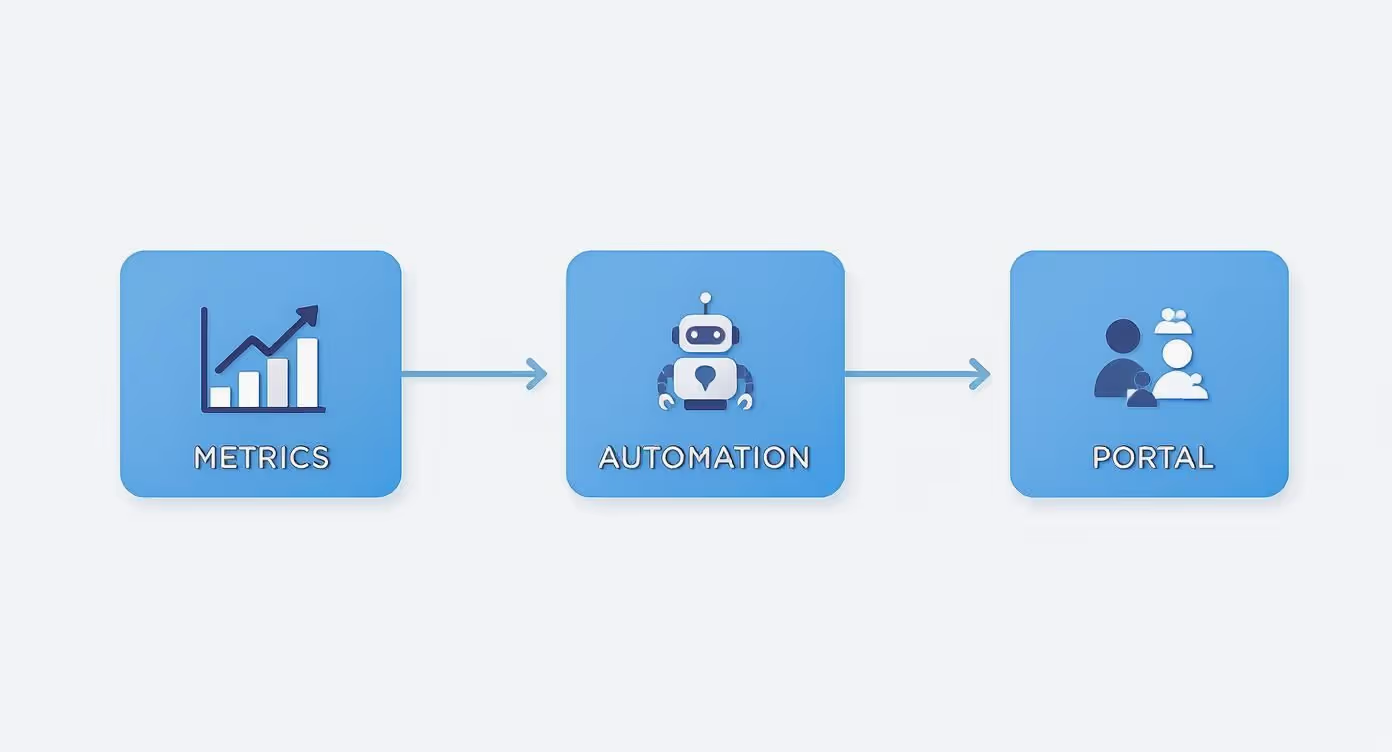Imagine a digital tool that works exactly the way your business thinks and breathes. That's exactly what it's about tailor-made web application. It is not just another software, but your strategic partner, designed for your unique processes. A solution that eliminates trade-offs and opens the door to true innovation.
Why the universal solution ceases to be enough
Today, when efficiency is the alpha and omega of success, more and more companies are moving away from universal “box” solutions. Instead, they invest in a digital “tailored suit” that fits their internal procedures perfectly. It's not just about convenience; it's about getting a real competitive advantage.

After all, standard software often forces you to adapt your processes to its limitations. In practice, this means unnecessary extra steps, manually rewriting data or juggling several unconnected systems at once. The result? Loss of productivity, higher error rates and frustrated employees.
A bespoke web app is like the digital twin of your business. It will not only simplify what you already do, but it will also discover new opportunities for automation and growth that were previously hidden behind the limits of finished products.
This guide will walk you through everything you need to know about the world of bespoke apps. We'll go nicely from the ground up and gradually work our way down to the details that will make you an informed partner for any development team.
What you will learn in this guide
Our goal is to give you a comprehensive overview of how custom software can take your business to a new level. Together we will explore the key areas so that you can make the right decision and choose a partner who turns your vision into a functional reality. Because a well-built digital tool is an investment that will pay you back many times over — in saved time, lower costs and more satisfied customers.
What awaits us?
- Comparison with ready-made solutions: We will find out when it pays to go your own way and when, on the contrary, it makes more sense to reach for a ready-made SaaS product.
- Key features and integrations: We will look at what specific problems the application can solve and how to connect it to tools that you have been using for a long time.
- Step-by-step development process: We will reveal what lies behind concepts such as analysis, design, programming and how the startup and subsequent support take place.
- Budgets and time frames: You get a realistic idea of the cost and time you need to factor in such a project.
But before you start planning your own app, it's crucial to be clear about how your existing digital channels are doing. A great stepping stone is complete website analysis. When you understand where you are now, you will be much better able to define the goals for your new system.
When is it worth building your own solution and when is renting enough?
Deciding whether to invest in your own development or rent a ready-made service (SaaS) is one of the most important strategic steps. It's not just about money -- it's about how your business will perform in the future.
Think of it as building a house. You can buy a type house from the catalog. It will be built quickly, it will work, and it will probably be cheaper. But it never will your house of dreams. Or you can hire an architect and build a custom home. It takes longer, it costs more, but every window, every door, every detail will be exactly where you want it to be.
It's exactly the same with corporate software. Ready-made SaaS solutions are great for everyday tasks — emailing, simple project management or invoicing. But if your business is tackling something unique, has specific workflows, or builds a unique competitive advantage, a type house will soon cease to be enough for you. You will start to run into its limits, and instead of making the software serve you, you will have to adapt to it.
Investing in your own solution is therefore a strategic choice for companies that are serious about growth and do not want to compromise.
When a finished SaaS product is the right choice
Finished products, known as SaaS (Software as a Service), are a great servant to standard corporate agendas. Their greatest strength is in the speed at which you can start using them and in the completely predictable cost.
SaaS is probably for you if:
- You solve a common problem: Are you looking for an invoice tool, a CRM for a smaller team, or a social network management software. Why reinvent the wheel when there are dozens of proven solutions on the market with thousands of satisfied customers.
- Pushing you with time and money: The initial investment is practically zero. You only pay a monthly or annual lump sum and you can use the tool almost instantly.
- Are you willing to adapt: Your business processes are flexible enough to align them with how the software works. You're not dealing with anything extra specific that the finished tool can't handle.
But you have to assume that you are just renting the software. You have absolutely no control over its future development, you are subjected to the pricing policy of the provider and sooner or later you will encounter limits in customization and integration with other systems.
When it pays to invest in a bespoke web application
Self-development is the way for those who want a digital tool that will become the beating heart of their business. It's an investment in the future that gives you absolute freedom and control.
Tailor-made web application development is becoming increasingly popular in the Czech Republic precisely because of its flexibility and perfect adaptation to the needs of companies. The key advantage is that applications do not need to be installed or updated, you just need to run them through an Internet browser. Explore more information about Customised application development from experts.
A self-made solution is ideal when:
- You have unique business processes: Your workflow is so specific that no “boxed” software can cover it meaningfully. Trying to bend it would be like stuffing a square peg into a round hole.
- You want a real competitive advantage: Your app is supposed to bring innovation that sets you apart from others. Whether it's a unique customer portal, advanced automation or an analytics tool that no one else has.
- You need absolute control over data and security: You are processing sensitive information or operating in an industry with strict regulation where you cannot afford the slightest compromise.
- Do you plan to grow and scale: You know that in a year or two your needs will be completely different. You need a system that will grow with you and allow you to add new features in the future without any restrictions.
Yes, the initial investment is higher. But you become Owner of key technologythat drives your business. You are not dependent on anyone and you are sure that your tool will always do exactly what you need from it.
Direct comparison or what is better for whom
To make your decision even easier, let's take a look at the key differences nicely side by side. This table will help you quickly navigate.
Comparison of tailor-made solution and finished SaaS product
Direct comparison of key parameters between the development of your own application and the purchase of an existing SaaS solution.
As you can see, there is no one right answer. SaaS is a great startup and solution for standardized needs, while a tailored application is an investment in the long-term efficiency, growth and uniqueness of your business.
What your app can do
It's a notion customized web applications often shrinks to internal systems and boring tables. But that's a huge shame. Think of it more like a blank canvas on which you can paint any digital tool that truly moves your business forward. Let's forget technical jargon for a moment and see what specific problems and opportunities such a solution can really solve.
The magic of self-development is that you are not bound by someone else's imagination. You can build exactly the ecosystem of features you need for your unique processes. Something that addresses the real pain of your team or customers.
Interactive dashboards and clear reporting
What if you opened a single report every morning and instantly saw the pulse of your entire business? Without clicking through five different systems, without manually downloading data to Excel. This is exactly what an interactive dashboard can do — it shows you the key metrics (KPIs) that really matter in real time.
From sales and warehouse status to production line load to customer satisfaction. Everything in one place, visually and completely understandable. This gives you incredible strength to react to changes immediately, not up to a week.
Add automated reports to that. The application itself can prepare and send a summary of the week to the entire management every Friday or generate documents for billing. With ease saves tens of hours of manual labor every month.
Customer portals and 24/7 self-service
Imagine that your customers do not have to call or write an email for every query. The customer portal is a digital gateway that gives them control and saves you valuable time.
What can such a portal do?
- Overview of orders and invoices: Clients can download what they need at any time or check the status of their last order.
- Service management: Allow them to adjust their subscriptions, change contact details or activate new services without having to talk to the operator.
- Reservation System: Whether you have a service, a practice, or provide consultations, clients book an appointment on their own according to your current capacity.
- Knowledge base and support: Create a clear section with frequently asked questions and tutorials. This will relieve your support team of recurring questions.
A custom portal dramatically increases customer satisfaction. It gives people the freedom and flexibility they are used to from modern digital services.
Integration and automation of business processes
But the true power of a customized web application is fully realized when you connect it with the tools you already use every day. This creates the central nervous system of your company, where data flows automatically, quickly and without errors.
Integration is not just a technical detail, it is a strategy. By connecting systems, you eliminate manual data overwriting, reduce error rates, and give your team time to do work that has real value.
Try to imagine that when a customer fills out a demand form in an application, this automatically happens:
- Create a new contact and business opportunity in your CRM (e.g. Salesforce or HubSpot).
- The trader is given a task to get back to the client within 24 hours.
- The customer will be included in an automated email campaign in Mailchimp.
- The entire sales team will receive a notification in Slack.
The growing demand for digital services in the Czech Republic shows that companies are increasingly looking for effective ways to optimize their work processes. Professional bespoke software, including ERP systems and portals, enables them to automate routine tasks and achieve significantly higher productivity. Find out more about the possibilities custom software development from Cleverbee.
The possibilities are practically endless. You can connect the application to accounting software, payment gateways, warehouse systems or external databases. The result is a perfectly matched orchestra, where each instrument plays at the right time and without a single false tone.
How an idea turns into a working application
Create tailor-made web application there is no magic. Nor is it a mysterious “black box” where you drop your idea and then just wait to see what comes out of it. On the contrary, it is a completely transparent and well-organized process in which you, the client, play the most important role. Your vision and perfect knowledge of your own business are the fuel that drives the whole project forward.
Let's see together what such a path looks like step by step. Knowing exactly what awaits you, you can better prepare for each stage, and the whole process will become not only more understandable for you, but also much more pleasant. Success is based on partnership and open communication.
Phase 1: Strategy and Analysis — Where It All Begins
It all starts with a single, but absolutely crucial word: “why”. At this initial stage, we are not dealing with button colors or specific technologies. Instead, together we dive into the heart of your business to understand to the point what your future application really has to prove.
Together, we ask ourselves a few crucial questions:
- What specific problem is the app supposed to solve? Do we want to save time and nerves for employees, reduce human error rates, shoot customer service to a new level, or open a whole new sales channel?
- Who will use the app? Are they your people in the office, customers, or maybe business partners? Each of these groups has completely different needs and expectations.
- What are the most important features that we simply cannot do without? This is how we define the so-called MVP (Minimum Viable Product) — the slimmest possible version of the application, but which already brings real value.
The outcome of this phase is not just some boring documentary. It is a clear plan and, most importantly, a shared understanding of where we are heading. This strategic foundation is absolutely crucial to ensure that the project does not go through a dead end. It's like building a house -- you also need solid foundations before you start putting up walls. And if you are thinking not only about the application, but about the overall digital business card, you may also be interested in our article on how they arise tailor-made website.
Phase 2: UX and UI Design — How People Will Feel About It
When we are clear about it, what and why we build, the question comes up, how the whole thing will work and look like. This stage has two faces that are inextricably linked with each other.
UX (User Experience) design is pure logic and functionality. The UX designer designs so-called wireframes. Think of it as a simple architectural plan of an application that defines the layout of the elements and the paths through which the user will move. The goal is one and only: to make the use of the application completely intuitive and natural.
You don't even notice good UX design. Everything just works exactly as you would expect, and you don't have to think about it at all.
It then follows smoothly UI (User Interface) designthat breathes life and a visual face into the application. UI designer turns austere wireframes into a beautiful and uncluttered interface. It selects colors, fonts, and icons so that everything matches your brand while supporting the easiest control possible.
The result is an interactive prototype that you can literally click through. Before a single line of code is written, you can see and feel exactly how your future application will behave.
This infographic nicely shows the typical process that the idea of an application goes through — from collecting data and defining metrics, to automating processes to creating a user portal. Each step logically follows the previous one and forms a solid foundation for successful implementation.
Each step logically follows the previous one and forms a solid foundation for successful implementation.
Phase 3: Development and Testing — The Magic Behind the Scenes
It is now the turn of programming itself. Our development team takes the approved design and starts turning it into functional code. We work in the so-called sprintech — short, usually two-week cycles. And the best part? At the end of each sprint, we show you a real, working piece of the app.
This agile approach has huge advantages:
- You have a constant overview: You see concrete progress on a regular basis and know exactly what's going on. No misting.
- Immediate feedback: If you find that something is not quite to your liking, we can adjust it right away. Not until the very end, when it gets expensive and complicated.
- Flexibility: The world is changing and your priorities may shift slightly as you evolve. Thanks to the agile approach, we are able to respond flexibly to this.
Hand in hand with development goes meticulous testing. We look for and fix the slightest bugs to make sure the app is stable, secure and runs like clockwork on all devices and browsers.
Phase 4: Deployment and Support — Start, not Destination
This is the festive moment! After your final approval, we will put the application into sharp operation. But our cooperation is far from over. On the contrary, it passes into a completely new, long-term phase.
Every application needs care. The world of technology is constantly evolving, which is why it is absolutely essential regular maintenance and support. We will take care of security updates, monitor its operation and ensure that your application runs smoothly and without any downtime.
What's more, we are here for you and for future development. Once you start using the app in real traffic, plenty of new ideas for improvements and other features are guaranteed to emerge. We are ready to continue to develop your application so that it grows with your business.
How to prepare for a budget and schedule?
“How much will it cost? “and “When will it be done? “I hear these two questions at every first meeting. And it's perfectly fine. They are key points for any business decision making. But in the world Tailor-made web applications there is no universal price list.
Think of it as building a house. Would you like an architect to get an instant estimate without knowing if you're planning a small ground-floor bungalow, or a sprawling villa with a pool, sauna and smart home? This is exactly the case with software.
The price depends on the size and complexity of your vision. A simple internal tool for five people will cost a fraction of what a robust client portal for thousands of users, connected to three other systems.
What moves the most with the price tag
To be more specific, let's show what has the biggest impact on the budget. Each of these things adds on complexity and translates into the hours your project swallows.
Key factors affecting the price:
- Complexity of functions: Ordinary display of data from a table is a completely different discipline than a complex calculator with dynamic variables or a reservation system with advanced availability logic.
- Number and type of integrations: Linking to one modern tool via a pure API is a cinch compared to connecting to an older enterprise system that no one has written documentation for in years.
- Requirements for UX/UI design: Do you need a clean and functional design, or are you craving a sophisticated visual experience with bespoke animations and illustrations that will amaze users?
- Level of security and regulation: Applications working with sensitive personal data (hello, GDPR!) or financial transactions requires a completely different level of security and testing.
Do you know what's most expensive about software? They are not the functions themselves. It's the links between them and the hidden complexity beneath the surface. The more the individual parts are intertwined, the more difficult it is to design, build and, most importantly, thoroughly test the whole.
Indicative budgets and time frames
Although each project is unique, we can sketch out a few typical scenarios. It will help you get at least a rough idea of where you are likely to be moving. Think of it as a starting point for your deliberations.
- Small internal application (approx. 80 000 — 250 000 CZK/2-4 months): It can be a simple attendance record tool, a small warehouse system for an e-shop or an approval process for internal documents.
- Medium-complex applications (approx. CZK 250,000 — 700,000 CZK/4—8 months): This typically includes a customer portal, a booking system for services or a more advanced project management tool with several integrations.
- Extensive enterprise system (from 700 000 CZK above/8+ months): Here we are talking about complex systems such as ERP, custom-made CRM or other key applications that control the heart of the company.
Why quality development takes months, not weeks
High-end software simply cannot be rushed. The analysis, design, coding itself, testing and deployment phases all need their time. Only in this way can a stable, safe and truly functional result be produced.
We avoid shortcuts that would later come back as a boomerang in the form of technical debt. It is an investment in the digital foundations of your business, which is why it is key to give the whole process the necessary space and care.
If you are wondering how app prices differ from regular sites, check out our article where we break it down average website price. It will help you get even better context.
How to find a reliable development partner
Choosing the right development partner is perhaps the most important decision you will make in the entire process. It's a choice that will affect not only the budget and deadlines, but most importantly whether your vision ever turns into reality. The wrong choice can mean months of work and money thrown out the window.

Remember, you're not just looking for a company that can write code. You are looking for a partner who will dive into your business, understand your goals and become your support. Because successful tailor-made web application It's always the result of a great collaboration.
Verification of experience and references
The first step is clear — take a hard look at what the potential supplier has been up to. Don't just settle for a pretty portfolio on the web. Want to see concrete results and don't be afraid to go into depth.
- Case studies: Go through their case files. Look not only for the final product, but also for the story — what problem did they solve, how did they approach it, and how did it have a measurable impact on the client?
- Relevant projects: Do they have experience with anything similar to what you are planning? Whether it's the same industry or a similar tech challenge, that's a huge plus.
- Call References: Request a contact at 2-3 former clients. This is absolutely key. Ask them how they communicated, if deadlines were met, and how the team dealt with the problems that always come up.
Honest feedback from real people will tell you more than any polished presentation.
Partnerships in software development are like a long-term relationship. Trust, open communication and a shared vision must work there. Technical skills are a necessary foundation, but without human chemistry and mutual understanding, nothing exceptional will ever arise.
Transparent process and communication
The way the company manages projects says a lot about her. There is no room for mists and secrets here. You want to see a clearly described process from A to Z.
Be interested in these key points:
- What does the initial analysis look like? How deeply will they be interested in your business before they get to work?
- How often will we call each other? Do you schedule regular weekly syncs? Who will be your main contact person?
- How do you handle assignment changes? Changes are normal. The important thing is to know what process they have for it and how it will be reflected in the price and terms.
- What will happen after launch? Do they offer a service agreement (SLA) that guarantees you clear reaction times and application care?
Red flags in the offer and contract
The last, but no less important step is a careful study of the price offer and the draft contract. Here, too, you can detect signals that should alert you.
Beware of:
- Suspiciously low price: If the offer is dramatically cheaper than the others, sharpen up. It can mean hidden costs, outsourcing to questionable quality or simply just underestimating the whole job.
- General formulations: The offer must specify exactly what is and what is not included in the price. If something is defined vaguely, it will later be a source of problems.
- Code Ownership: The contract must say in black and white that after payment you are 100% owner of the source code. Anything else will tie you dangerously to one supplier.
The right partner is an investment that will return you many times over. Therefore, choose carefully and do not rush. The right team will not only understand your vision, but help take it even further than you originally imagined.
Do you have questions? Here are the answers
Embarking on developing your own app is a big decision. It's perfectly natural to have a lot of questions running through your head. Let's look at the most common ones so that you are clear about this and can make the right choice.
Why should I own the source code?
Think of it as building a house. Owning the source code means you have complete blueprints and house keys. You can remodel it at any time, redecorate it or invite another architect to expand it for you. No one can dictate terms to you and your investment is truly yours.
Without the source code, you're basically just renting the house out. You are dependent on the “owner” (supplier) and have no certainty for the future. Ownership of code is the absolute foundation for your freedom and security.
I've heard of agile development. What does that mean to me?
In simple terms, agile development is the opposite of building “blind”. Instead of describing every detail at the beginning and then waiting two years for the result, we build the app in small, functional parts.
For you, this means that very soon you will see the first results and you can touch them right away. This will make you realize in time what works great and what could be done better. This way we can respond flexibly to changes and ensure that the final product is exactly what your business really needs, not just what we thought at the beginning.
Do I need to come up with a detailed technical specification?
Not at all. That would be like having to explain to a car mechanic exactly how to fix a transmission. You best understand your business, your goals and the problems you want to solve.
Your task is to describe what you want to achieve. Our task is to transform your vision into a functional technical solution. That's what you hire us from.
You can recognize a good partner by asking about your business and only then writing a technical assignment together with you.
And what happens after launch? Who will take care of the app?
It certainly does not end with the launch - on the contrary. Just as a car needs regular service, the app requires care to stay safe, fast and reliable. The world of technology is constantly changing and needs to be responded to.
A reliable supplier will always offer you a service contract (SLA) that takes care of:
- Regular updates: They keep the app safe and fit.
- Monitoring and backup: We constantly monitor that everything runs smoothly, and we have a safety net ready for emergencies.
- Guaranteed support: It gives you peace of mind because you know that when anything happens, you have someone to turn to and the problem will be resolved quickly.
This aftercare is an insurance policy that your investment will deliver value for years to come.
We hope that we have helped you to see under the cover of the development and perhaps inspired you. If right now you are looking for a partner who will enthusiastically turn your vision into a real tool, Oldfriend is there for you. Let's build something together that moves your business forward. Arrange a non-binding consultation with us.



